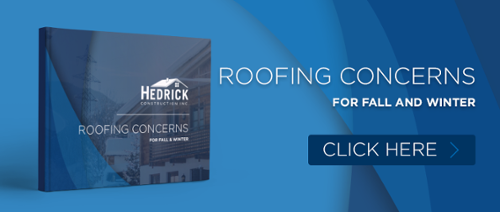
When cold weather reaches the Midwest, snow and ice are sure to follow. If you prepare early in the season, you can have your roof and attic inspected to make sure everything is ready for winter. Before the snow starts to pile up, take measures to prevent ice dams from forming so you can avoid the trouble of getting rid of them or paying the price of dealing with the damage they can cause.
What are ice dams?
Ice dams are ridges of ice that can form at the edge of a roof. This ridge grows as water melts and refreezes over and over again on top of it, literally forming a dam that continually builds on itself. These ridges often prevent water from draining properly from the roof. Backed-up water behind these dams can seep through the roof and into the home, causing damage to ceilings, walls, insulation, gutters, paint, drywall, and more.
Why do ice dams form?
Ice dams form because snow melts on the roof, flows to the edge, and refreezes at the eaves before running off onto the ground or into the gutters. Snow often melts as a result of varying temperatures across your roof. Warm air rises from inside your home to the top of your attic. The warmer areas of your attic then melt the snow above, and when the melted water reaches colder areas, it freezes again. The goal is to keep temperatures below freezing and consistent across the entire roof.
How do I prevent ice dams from forming on my roof?
A few factors play into the successful prevention of ice dams. The three main areas of concern are your attic insulation, ventilation, and bypasses (areas where air leaks). To prevent ice dams from forming, simply increase ventilation, stop air leaks, and add insulation where necessary. You’re right…it’s a little easier said than done.
1) Air Leaks
Any areas that are allowing warm air from below (inside the home) to enter into the attic need to be sealed. The goal is not to keep your roof warm, but to keep it cooler than 30 degrees Fahrenheit so the snow on it doesn’t melt and form ice dams at roof edges. Seal any leaks you see around vents, and fill in any holes. Also make sure the flashing between your chimney and roof is working effectively. If not, you may need to add or replace flashing and add fire-resistant sealant around the chimney.
2) Insulation
Insulation is responsible for keeping the warm air from inside the home away from the roof area. It is important for the area between the roof rafters to be well insulated, as well as the attic floor. Also, cover the attic hatch with a weatherstripped cap. Some older homes have whole-house fans. They are usually not insulated well, so if you have one of these, be sure to cover it properly to keep the heat inside the house and out of the attic space.
To prevent heat from entering the attic from below, make sure you check the following areas to assure that they are sealed and insulated properly:
- Attic floor
- Heating ducts
- Recessed ceiling lights in the room below the attic floor
- Attic entrance (door or hatch)
- Vents fans that vent to the attic
- Ductwork
3) Ventilation
For your roof to keep an even temperature across its surface, it needs to circulate cool air underneath the whole roof and allow any heat to escape so that certain areas aren’t warmer than others. For proper attic ventilation, a home needs sufficient soffit and ridge venting. To help you determine the best way to properly ventilate your attic, have your roofing contractor come out and do an inspection and advise you on the best way to proceed. Also, make sure that any ducts that are connected to your bathrooms, kitchen, and dryer lead outside through walls or the roof, but not through the soffit.
4) Gutters
Before the snow hits, make sure your gutters are cleared of debris. Now that most of the leaves have fallen, it is a great time to do this. Blocked gutters can cause some very serious issues during the winter.
By preparing ahead of time, you can ensure your home is ready to take on everything winter weather may bring. To learn more about what potential roofing problems to look for during the colder months, download our free ebook.








Comments